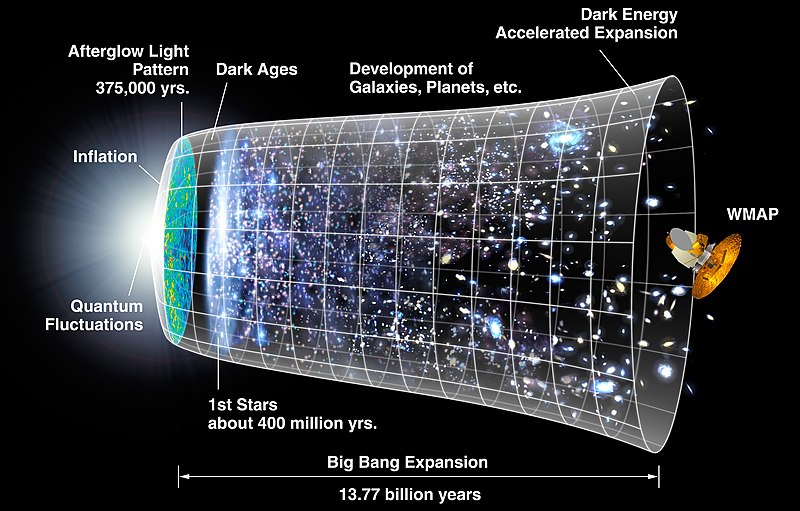- In Image 1,
the 2
dimensional
cosmic time slices represent
3
dimensional
space at each era.
The slices exhibit exponential growth from the beginning to the end of hypothetical inflation era. After that, the slices grow more slowly with Friedmann equation evolution as given by the Λ-CDM model which consistent so far with the observed expansion of the universe.
The growth illustrated in the Image 1 is not-to-scale.
- The expansion of the universe
means the growth of space itself.
How this is possible is explained
by the theory of
general relativity of
Albert Einstein (1879--1955).
The growth of space is just a scaling up of space in the Λ-CDM model and in Friedmann-equation (FE) models in general. These cosmological models are solutions of the Friedmann equation which is derived from general relativity plus extra cosmological assumptions: the main ones being cosmological principle (i.e., the assumption that the observable universe is homogeneous and isotropic in average properties on a large enough scale) and that actual mass-energy contents of the observable universe can be approximated by a perfect fluid.
- The
expansion of the universe is actually
only the growth of space between
bound systems.
You and yours truly, the planets (and smaller astro-bodies), the stars, the galaxies, galaxy groups and galaxy clusters are NOT expanding.
- Before stars,
galaxies,
and the
large scale structure
of the observable universe formed, the
expansion of the universe
just caused a decrease in the
cosmic density,
and thus a decrease in the cosmic density of the
primoridal light elements
(hydrogen (H-1),
deuterium (D, H-2)
helium-3 (He-3),
Helium-4 (He-4),
and lithium-7 (Li-7)),
cosmic background radiation (CBR)
(which evolved to the present-day
cosmic microwave background (CMB)),
cosmic neutrino background, and
dark matter
(whatever that is).
- Notable cosmic eras:
- inflation era (cosmic time ∼ 10**(-36)--10**(-33) or 10**(-32) s).
- Big Bang nucleosynthesis (cosmic time ∼ 10--1200 s ≅ 0.17--20 m).
- cosmic dark age (∼ 377 kyr (z ≅ 1100) -- ∼< 200 Myr (z ≅ 20)).
- cosmic dawn (AKA reionization era, z∼6--20, cosmic time ∼ 150 Myr--1 Gyr in the Λ-CDM model).
- cosmic noon (z∼1.5--2.5, cosmic time ∼ 3--4 Gyr, lookback time ∼ 10--11 Gyr) .
- formal cosmic time zero (i.e., t=0)) to cosmic present = to the age of the observable universe = 13.797(23) Gyr (Planck 2018).
- See also, Wikipedia: Age of the universe, Wikipedia: Big History, Wikipedia: Chronology of the universe, Wikipedia: Timeline of the far future, Wikipedia: Ultimate fate of the universe, etc.

Features: